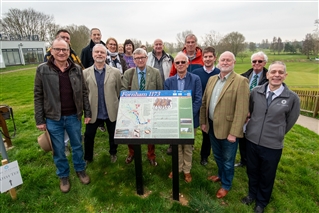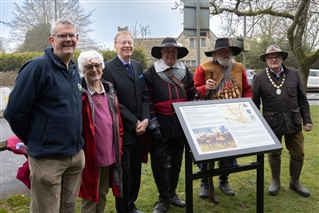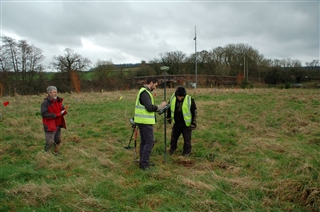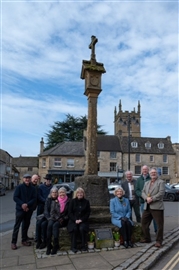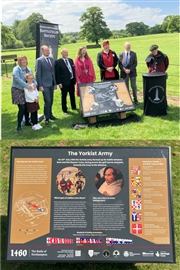News
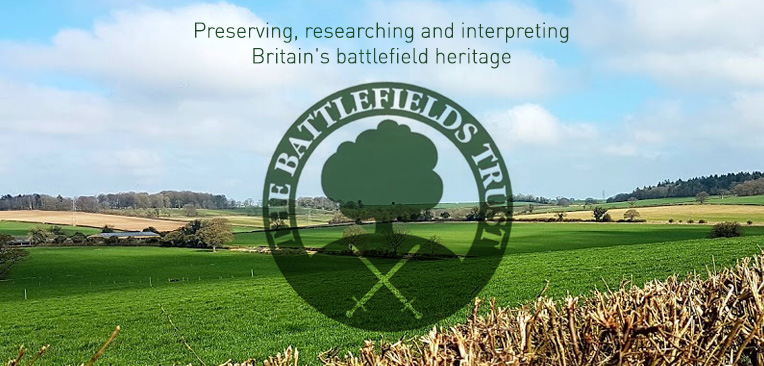
Notes for the Response to the NPPF
4 October 2011
NATIONAL PLANING POLICY FRAMEWORK
The Battlefields Trust (www.battlefieldstrust.com) welcomes the opportunity to comment on these proposals and engage in a debate on the future of the planning system in England. The Trust welcomes measures to clarify and simplify the planning system where they are balanced against the risks of uncritical and unsympathetic development not based on here-and-now bottom-line criteria. There are helpfully clear and explicit comments relevant to heritage protection in the paper (e.g. para 81), but the Trust’s concern is that it would be too easy for developers and local planning authorities to ignore or marginalise them for reasons set out in the more detailed comments below.
From the Trust’s perspective the biggest weakness in the current planning regime is that battlefields (along with other heritage assets such as historic gardens) enjoy no statutory protection at all. This was to have been addressed in the Heritage Protection Bill, but is addressed neither in the current Planning Policy Statement 5 nor in this consultation paper. The Trust asks that the planning process accords parity of protection to all types of heritage asset mentioned in the paper, but would be happy to discuss arrangements to prevent this being perceived as an unreasonable requirement or uncritical bar to development proposals as they might affect battlefields.
Some of the perceived flaws in the proposals may derive from the Practitioners Advisory Group having contained no groups expert on the issues affecting heritage assets not already enjoying statutory protection. The Trust urges you to look carefully at English Heritage’s views on this and restore a level playing field.
These are the Trust’s observations on the proposals in more detail:-
- The guidance on the historic environment needs to be increased to ensure full coverage of all heritage assets and more explicit information for developers and objectors – as was done in PPS5 previously.
- The benchmark of “sustainable development” needs further qualifying. What developer is going to volunteer that their development is not sustainable? It risks being a self-fulfilling prophecy. The Trust has had experience of an applicant – supported by a (now abolished) local planning authority (LPA) - who classified a single wind turbine for private use at a single property as a more sustainable development of more value to the local economy than a (staffed) visitors’ centre to display a heritage asset.
- Heritage assets are non-renewable, so any proposal that prejudices a heritage asset must be deemed “unsustainable” and this should be written into the guidance.
- Heritage assets of national importance should not be at risk of being disposed of for purely local convenience and profit behind the veil of sustainable development supported by neighbourhood groups.
- To make the proposals workable and credible, there needs to be a statutory obligation on local planning authorities to record all heritage assets and explicitly take them into account as a material consideration in the planning process. At present assets not enjoying a status such as listed building or scheduled ancient monument can slip through the net. This particularly applies in the context of para 14 of the Introduction. The Trust has had experience of a local planning authority refusing to acknowledge English Heritage’s registration of a battlefield until the matter was referred to the (now abolished) relevant Regional Office. If this is to be addressed in the Localism Bill through an enforceable register of community assets, then the Trust will be content, but, if not, this is a major objection to the proposals.
- There is an almost complete absence of acknowledgment of the economic importance of tourists visiting heritage assets. People do not visit sites to see “sustainable developments” but they do visit heritage assets specifically for that purpose. The income they generate locally supports all the other aims of the NPPF. Risking reduction of that income flow risks prejudicing those targets.
- The tunnel vision concentration on housing risks making this framework specific to 2011. Had it been drawn up with the same ethos 20 years ago, then the only priority might have been office development. Balance and future-proofing is needed.
- In para 9 of the Introduction, the protection of heritage is initially excluded from the criteria for sustainable development. The term needs to appear in the opening section and not just be buried in the sub-text below.
- In terms of para 16 of the Introduction, heritage assets should enjoy the same level of protection as sites covered by the Birds and Habitats Directive. This should have been achieved (albeit by a different route) in the Heritage Protection Bill, whose principles all Parties at Westminster still endorse even though it has been indefinitely deferred.
- In para 19, bullet point 2, of the Introduction, reference should be made to heritage protection alongside the other objectives.
- Bullet point 5 here is unfortunately worded. If all tourism ceased, then the reduction in carbon emissions from people ceasing to travel to heritage assets would appear to meet the target here, but at the cost of throwing out several babies with the bathwater.
- In bullet point 6, a planning regime with a tunnel vision focus on housing development will not create a “vibrant environment”.
- In para 50 (on Neighbourhood Plans) the Trust again draws attention to the need to make it a statutory obligation for local planning authorities to record and take into account all material considerations. All the neighbourhood proposals seem to run the risk of decisions being taken by self-interested parties, behind closed doors and with no accountability or transparency. The neighbourhood proposals risk the perverse effect of a massive shift of power to Whitehall and the disenfranchisement of local organisations.
- The Trust would welcome the opportunity to discuss the arrangements for “statutory consultees” to put this provision on a more coherent and logical basis than in the current regime, which seems to be random and ad hoc.
- It would be useful to know more about the referendum process (e.g. as in para 52 or 66) and who will be eligible to engage in it. The proposals seem to offer the anomaly of 21 people expressing a desire to live on a battlefield (or in an historic garden) being constituted as a neighbourhood, holding a referendum to sanction a development of their choice and then seizing control of the planning process.
- Para 117 is also unfortunately worded so as to suggest that heritage assets are all potentially under threat from the proposals.
- In the context of paras 180-4, the Trust again draws attention to the perverse outcomes that could ensue if a developer, with the support of the local planning authority, simply makes no reference to a heritage asset to be lost or prejudiced by a development proposal.
- There is no reference to the protection of landscapes and views in the proposals. As drafted the risk is that a heritage asset (whether battlefield, stone circle or cathedral) can still be protected if a multi-storey apartment block is built on a skyline next to it.
The Trust is concerned that the imbalances in the proposals will have the effect of undermining them. The presumption in favour of housing development, combined with the fast-track procedures that may allow consent to be a fait accompli with taking material considerations into account, mean that decisions will be much more open to challenge and Judicial Review. In other words, the courts will have to intervene to restore natural justice to the system. This will make the system far slower and more costly than the present arrangements. The main solution to this is to place a statutory duty on LPAs to list all heritage assets and make them a material consideration in the process.
On a similar theme, the planning system needs to enjoy public confidence through accountability, transparency and the exercise of local democracy by communities (as opposed to self-constituted self-interested groups, possibly of complete outsiders). The current proposals do not demonstrate these, and it would do no service to potential providers of – say – affordable housing designed sympathetically if they had to operate in a discredited system.
There is much assertion but no evidence about the failures of the present system or the viability of the alternatives proposed. It would have been useful to include some case studies of development proposals meeting local needs, to high design standards and supported by the community being thwarted. As presented, the proposals do not pass the test of being “evidence based”.
The consultation asks whether guidance should be provided by bodies other than government. The Trust asks that guidance on expert areas – whether refuse incinerators, battlefields or sites of special scientific interest – be prepared by bodies expert in the field.
The Trust has not commented on impact assessment. This will fall into place if LPAs are given appropriate powers at the start of the planning process, but hangs in the air with the proposals as drafted.
The Trust would be pleased to provide any further information and to meet and discuss any matters here, either alone or together with the Heritage Alliance.
 Now available! A field guide to registered historic battlefields in England
Now available! A field guide to registered historic battlefields in England
18 November 2025
Read More
 Battlefields at risk - Historic England publishes its revised Heritage at Risk register
Battlefields at risk - Historic England publishes its revised Heritage at Risk register
6 November 2025
Read More
 Formal Launch of the Wars of the Roses Memorial Database
Formal Launch of the Wars of the Roses Memorial Database
15 October 2025
Read More
 Big Battlefield Walks Weekends prove successful despite the weather
Big Battlefield Walks Weekends prove successful despite the weather
23 September 2025
Read More
 HS2 damages nationally important battlefield
HS2 damages nationally important battlefield
18 September 2025
Read More
 Bosworth battlefield sculpture trail opened
Bosworth battlefield sculpture trail opened
18 September 2025
Read More
 Worcester's Civil War heritage brought to life with striking new banner installation
Worcester's Civil War heritage brought to life with striking new banner installation
16 August 2025
Read More
 Wars of the Roses Memorial Database Launched
Wars of the Roses Memorial Database Launched
29 March 2025
Read More
 Battlefields Trust Journal 2024 Published
Battlefields Trust Journal 2024 Published
19 March 2025
Read More
 Powick Old Bridge repairs progressing
Powick Old Bridge repairs progressing
18 March 2025
Read More
 Battlefields Trust enlists cross party MP support to engage government on battlefield protection
Battlefields Trust enlists cross party MP support to engage government on battlefield protection
20 January 2025
Read More
 New Civil War battlefield memorial and information board unveiled at Middleton Cheney
New Civil War battlefield memorial and information board unveiled at Middleton Cheney
6 June 2023
Read More
 Battlefields Trust Journal - Call for submissions
Battlefields Trust Journal - Call for submissions
20 October 2022
Read More




